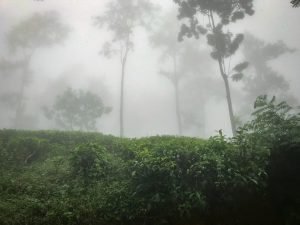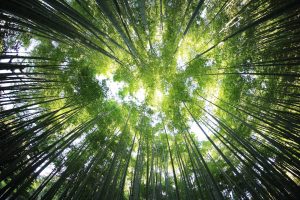Monoculture, for-profit plantations, and the health of forests
Charlie Jaay – December 1st 2022
Charlie Jaay explores a terrifying crisis within a crisis — misplaced and misleading tree-planting initiatives which, rather than mitigating the climate emergency, compound it, threatening communities and ecosystems.
Each year, 10 million hectares of natural forest are lost worldwide, while fast growing industrial monoculture plantations of uniform species rapidly expand. This is happening not only because of increased demands for products such as timber, pulp and paper, but also under the pretext of climate change mitigation as nations around the globe pledge to rebuild and increase forest cover by planting millions of trees.
These plantations often provide raw materials for ‘biofuels’ and, although regular harvesting and clearing releases stored carbon dioxide back into the atmosphere, it’s claimed they also act as powerful carbon sinks, and so are regularly included in offsetting plans for industrial carbon emissions.

Many sites are in countries of the developing south, where low production costs, cheap land and labour, government incentives, and much lower standards in legislation for environmental protection have ensured abundant and cheap supplies of raw material. Usually made up of non-native species such as eucalyptus, pine and acacia, the aim is maximum profit from minimum labour.
A number of global goals aim to ‘restore degraded and deforested land’. The Bonn Challenge, launched in 2011 by the German government and International Union for Conservation of Nature, aims to ‘restore’ 350 million hectares of ‘forest’ across the tropics and subtropics by 2030. Over 40 countries are involved, including Brazil and China. Closer research has revealed half the pledged area has been earmarked for monoculture plantations.
Such schemes have devastating environmental and social impacts. While natural forests represent some of the richest biological areas on earth and provide a vast range of products and services which are of immense importance to human survival and life on earth, and offer vital defence against climate change and biodiversity loss. The same cannot be said of industrial plantations.
 |
Professor Adrian Newton, Director of Conservation Ecology at Bournemouth University, co-chair of the IUCN/SSC Global Tree Specialist Group (GTSG), and author of several books, including Ecosystem Collapse and Recovery, believes the establishment of these plantations often constitutes a form of ecosystem collapse.
‘If a natural forest is converted to a plantation, entire ecological communities will be destroyed, species diversity will be massively reduced, and ecological processes will be irrevocably altered’, he says. These plantations affect soil structure and deplete organic matter and nutrient levels, essential bacteria and microorganisms.The result is reduced soil fertility, leading to large quantities of artificial fertilisers being used in addition to herbicides and insecticides to fight the increased risk of disease and insect attacks.
|
The chemicals impact far beyond the plantation itself, contaminating soil, waterways and atmosphere and affecting people, plants and wildlife. Overuse results in resistance, so measures continually increase, as does the environmental impact. Also requiring vast amounts of water, the threat to fragile forest ecosystems is compounded by increased risk of extensive wildfires as the dense timber is highly flammable.
According to Dr. Simon Smart, Senior Research Scientist and Botanist at the UK Centre for Ecology and Hydrology, several factors limit the biodiversity found in monoculture tree plantations, compared with mixed aged broadleaved forests.
‘The very unnatural density at which single-aged cohorts are planted mean that very few plant species are specialised to grow under the unusually low light levels beneath forest monocultures’, he explains. ‘This severe light limitation to the under-storey is a year-round phenomenon, as most fast-growing planted tree species keep their leaves all year round.
‘The number of plant species able to survive here are also limited… such as conifers and eucalyptus, which increase soil acidity,’ Smart continues. ‘In terms of animal and bird species, a limited number can grow on, in, or otherwise use monocultures. Since many planted species are also not native to the country in which they are planted this can also reduce the extent to which the forest can support other life’, he explains.
In the face of rapidly increasing deforestation, the timber industry, governments and international organisations such as the United Nations Food and Agriculture Organisation (FAO), and the Forest Stewardship Council (FSC), regularly describe these monocultures as ‘forests’, which has been used to legitimise the expansion of industrial plantations, often at the expense of threatened native forest ecosystems.
Under FAO’s definition, replacing native forest with tree plantations is not recorded as deforestation, which enables countries to obscure the loss of native forests when they report their forest cover data to the FAO. China is one of these states.
Between 2000 and 2015, after the country’s major forest protection and reforestation policies came into effect, the region’s gross tree cover grew by over 30%. But research has found this increase was entirely due to the conversion of croplands to tree plantations, especially monocultures, while native forests suffered a net loss of almost seven percent. China claims to have carried out more than 3.5 million hectares of afforestation in 2021, yet we do not know how much native forest has been lost in the process.
‘Industrial tree plantations are not forests’, indicates Klaus Schenck, of German NGO Rainforest Rescue. ‘These monocultures are green deserts which destroy biodiversity, soils, water supplies and the livelihoods of the people.’

During the Pinochet dictatorship in Chile, vast expanses of natural forest belonging to the country’s Indigenous Mapuche communities were converted into industrial plantations for the pulp and paper industry. These were heavily subsidised by the state until 2012 under the pretext of promoting regional development. Timber plantations expanded by a factor of ten between 1975 and 2007, replacing natural forests by a third in some areas, and now occupy almost half the southern-central Chilean landscape.
Two companies, Forestal Mininco SpA and Forestal Arauco S.A., account for almost two million hectares of industrial tree plantations in the country combined. These consume vast amounts of water, with each eucalyptus requiring around 30 litres every day, and pine slightly less. In conjunction with higher temperatures caused by climate change, these plantations are causing drought, and also extensive wildfires due to their dense flammable timber. This threatens the remaining natural forests and their ecosystems, as well as the global climate.
Reynaldo Mariqueo, General Secretary of Mapuche International Link, says” ‘The deforestation of native trees for extensive pine and eucalyptus plantations dried up the underground water tables and streams. It created erosion and drought, devastating the ecosystems and biodiversity of the region, including the medicinal plants.’
‘The abandonment, defencelessness and lack of justice has pushed many communities to develop peaceful protests of direct action, aimed at boycotting the forestry business and recovering the lands of their grandparents or great-grandparents’, he continues. ‘The adverse environmental effects not only impact the Mapuche communities, but also non-Mapuche small farmers, and others, and have caused the protest to spread and intensify. This has led the current government, like the previous ones, to declare a state of emergency, and militarise a large part of the Mapuche ancestral territory.’
Elsewhere, monoculture tree plantations are expanding in Africa, helped by the African Forest Landscape Restoration Initiative (AFR100) and other global programmes, which contribute to the Bonn Challenge. Launched in 2015, by the World Bank, FAO, the German Ministry of Economic Cooperation and Development (BMZ), and other agencies, during the Paris Climate Agreement AFR100 claimed it would ‘restore’ 100 million hectares of deforested and degraded land in Africa by 2030. Industrial monocultures will play a big part in the project.
 |
However, most land classified as ‘deforested and degraded’, and used to establish monoculture plantations by plantation companies is either community land used for food production, or native vegetation. The result is that native vegetation such as forests or ancient savannah landscapes, including Tanzania’s Serengeti and South Africa’s Kruger National Park, are mapped as deforested and degraded, because tree cover is reduced by elephants, antelope, and several million years of grass-fuelled fires.
Some national governments have also launched tree-planting initiatives, as in Mozambique, where the government plans to plant one million hectares of trees by 2035 through its Forest Agenda 2035. There are currently around 70,000 hectares of monoculture plantations in the country, mostly eucalyptus and pine. The timber is mainly exported, and the majority is used for electricity poles, paper and pulp. ‘These industrial tree plantations come with a false narrative — that they are for reforestation, to restore ‘degraded’ land, and a solution to the climate crisis. But these are lies. In reality, these monocultures are increasing poverty, and destroying native species and productive ecosystems’, says Anabela Lemos, Director of Mozambique-based social justice organisation, Justica Ambiental.
|
‘Fossil fuel companies, such as ENI, Shell and Total, are a growing problem here. They use carbon credits or REDD to offset their emissions and finance plantations, grabbing huge amounts of land to ‘reforest’ with exotic trees, which will later be cut down to make money- just so they can carry on as usual’, Lemos explains. ‘At the same time, here in Mozambique, these companies are exploring for gas, increasing emissions, destroying sensitive natural ecosystems and taking the territories and livelihoods of rural communities.’
According to Lemos, the two biggest plantation companies operating in Mozambique, Portucel and Green Resources, both cleared natural vegetation to establish their plantations, resulting in numerous conflicts with affected communities, who complain of many false promises. They have lost fertile land, access to natural resources, including water points and, for many, their only revenue stream: the land itself.
Although oil palm is not defined by the FAO as forest cover, the expansion of monoculture oil palm plantations, in addition to those species used for timber, wood pulp and paper, is driving major deforestation in some of the world’s largest rainforests across Indonesia, Malaysia and Papua New Guinea.
Claire Oxborrow of Friends of the Earth says: ‘These industrial monocultures are controlled by powerful corporations, and threaten precious wildlife like orangutans and sun bears. It’s also fuelling the climate crisis as fires, often started deliberately to clear forest, can spread and lead to devastation as in 2015, when Indonesia’s carbon emissions tripled.
‘The UK plays a key role in driving this destruction, importing over a million tonnes of palm oil a year to manufacture products like chocolate, margarine and soap. Most of this comes from South East Asia,’ she adds.
With the dual crises of biodiversity loss and climate change, it is more important than ever our natural forests and local communities are protected. For this to happen, stronger laws to protect forests and communities, the pursuit of sustainable agricultural systems, and the facilitation of native forest restoration is vital. As is forcing countries like the UK to introduce legislation that requires companies to prevent human rights abuses and environmental harm within their operations and supply chains.
This article features in the latest issue of Air Quality News, as part of a Special Report on Health. Read the full magazine below.
________________________________
Source: Air Quality News.com
